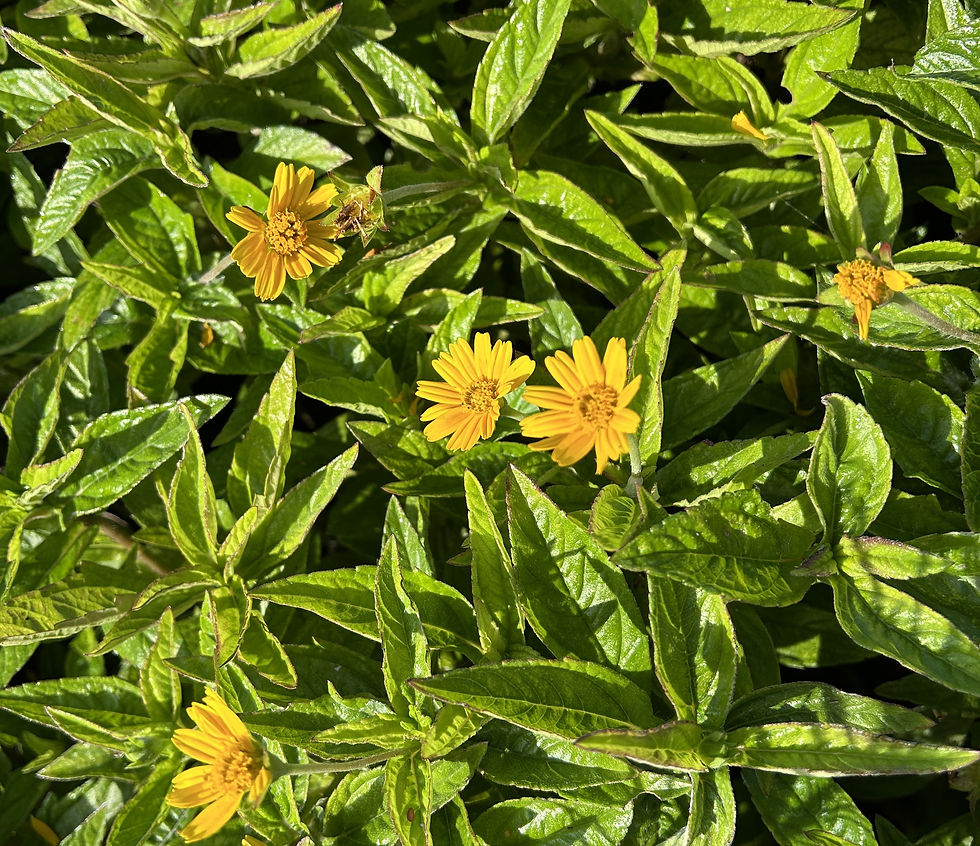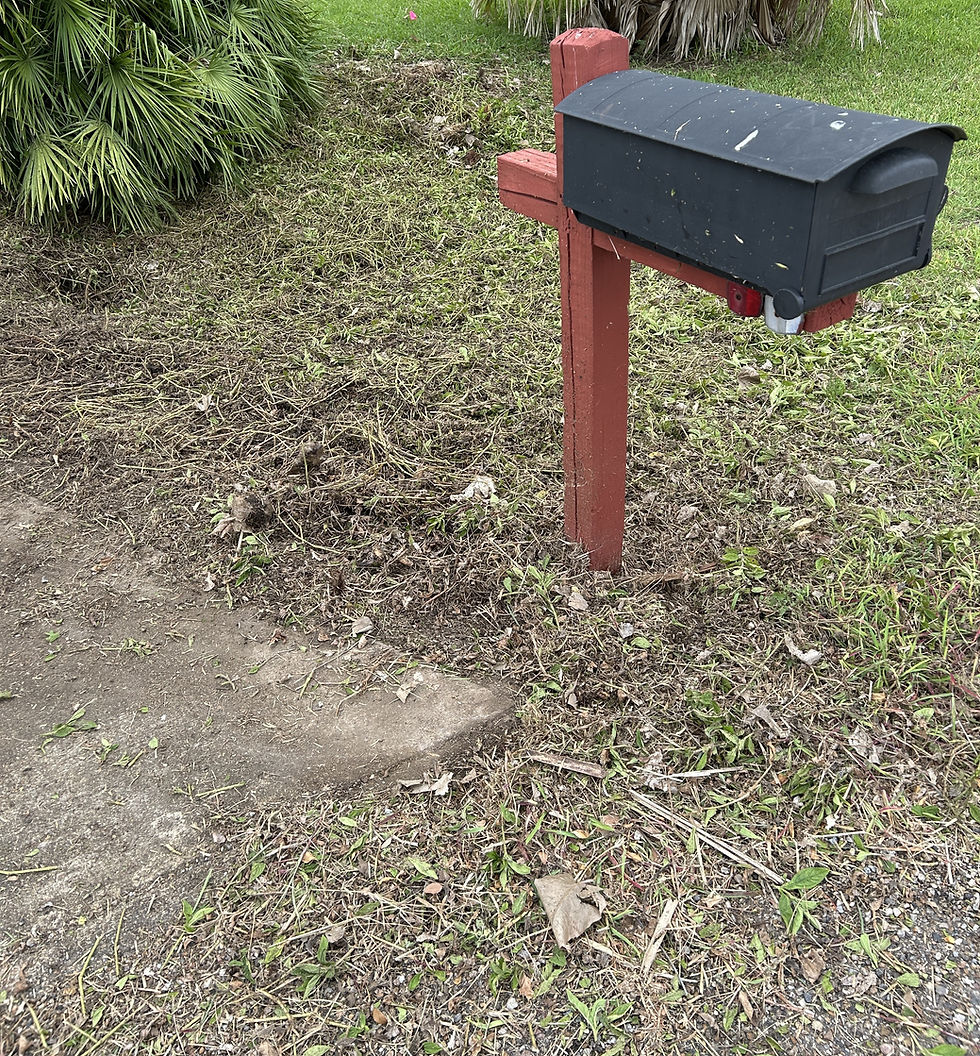Anita’s Blog – Invasive/Aggressive Part 2
- jjvanm
- Aug 29
- 6 min read

Part 1 of this 2-part series described invasive plants as always nonnative species. Invasive plants have the ability to spread aggressively; they negatively impact the environment, economy or human health. Part 1 is at this link: https://www.stbctmn.org/post/anita-s-blog-invasive-sacred-fig
The moral of this 2-part series is: be careful what you plant.
Part 2 is about trailing daisy, Sphagneticola trilobata.
As mentioned in Part 1, trailing daisy is not listed as invasive at the Texas Invasives database. However, the Lady Bird Johnson Wildflower Center considers it invasive; it has been included in the American Lands Alliance’s list of worst U.S. invasive plant species (PIER, 2014); and the International Union for Conservation of Nature’s (IUCN) Global Invasive Species Database lists it as one of the world’s 100 worst invasive species. Personally, I will side with those designating it an invasive species.
Regardless how one chooses to regard trailing daisy, it is nonnative, it is aggressive.
In Part 1, a quick Internet search gently described aggressive plants as “native plants that spread faster than preferred.” There’s a lot more to it than that. Aggressive plants can be native, nonnative, naturalized, cultivated and even invasive plants can be aggressive.
Aggressive plants may, or not, be limited to a specific garden or area. Some plants might be aggressive in one area and hard to grow 15 miles away, like native Dicliptera sexangularis, sometimes commonly called six angle fold wing, that seemed nearly as prevalent as Guinea grass, Megathyrsus maximus, at times in Harlingen’s Hugh Ramsey Nature Park, while reportedly hard to grow in neighboring Weslaco, Texas.
Relentless, persevering, nuisance are often words used to describe aggressive plants. Other comments include, plants thriving in conditions like urban pollution and nutrient distressed soil; aggressive plants are those that generally spread quickly and easily, either by 1.) seed; 2.) by rhizomes (horizontal stems that grow underground or along the soil); or 3.) by stolons (horizontal stems that grow above or just below the soil surface, rooting at nodes, forming new, independent plants) – basically, they spread by non-seed, vegetative propagation.
Well-known plants with a broad global distribution known to be classic aggressive plants are those in the mint family. Think of our native pink mint plant, Stachys drummondii, important during the winter months because it produces useful nectar and pollen December through April; plants may overtake gardens and lawns temporarily; the plants die back in the heat of summer.
Many Deep South Texas native vines are aggressive and can overtake fences, shrubs, trees, scrubland, buildings and small nations, like possum grape, Cissus incisa; climbing hemp weed, Mikania scandens; and Mexican snailseed, Nephroia diversifolia. The habits of old man’s beard, Clematis drmmondii; and climbing milkweed, Funastrum cynanchoides are described at this link: https://www.stbctmn.org/post/take-time-to-admire-fall-s-showy-native-vines; and littlefruit slipplejack, Serjania brachycarpa on page 5, Winter 2024 Issue of The Chachalaca newsletter: https://rgvctmn.org/wp-content/uploads/2024/12/Winter-2024-issue-of-The-Chachalaca.pdf
In addition to the earlier descriptors of aggressive plants, the phrase, running rampant describes nonnative, trailing daisy, Sphagneticola trilobata, a plant that we’ve encountered in the yard at our new residence. It is an aggressive ground cover – ground cover in the true sense of the word in that it is covering much of the ground on our small acreage. It is vine like. It is described as a spreading, mat-forming perennial up to 12 inches in height. Stems are up to 15 inches long, rooting at the nodes, propagating vegetatively. Leaf edges are serrated; the tops are covered in fine hairs and cause unprotected skin to itch.
Trailing daisy is native to Mexico, Central and South America. Also called creeping oxeye, wedelia and Chinese wedelia, (not to be confused with our lovely, habitat-useful native hairy wedelia, Zexmenia hispida).
Trailing daisy has a very wide ecological tolerance range, according to Wikipedia. “It spreads vegetatively, not by seed. It rapidly forms a dense ground cover, crowding away and preventing other plant species from regenerating. It is a noxious weed in agricultural land, along roadsides, urban waste places and other disturbed sites. It is also invasive along streams, canals, along the borders of mangrove swamps and in coastal vegetation. The species is widely available as an ornamental and is therefore likely to spread further.”

When I tackled what we considered a big yard problem and began attempting to eradicate massive areas of the trailing daisy, I jumped in with both feet – and a weed eater – and didn’t think to take before photographs – yes, an unusual trait for a photojournalist, but there you have it. Below is an after shot. The vegetation took up huge areas at the entrance on both sides of our driveway at the drainage ditch, clogging the culvert under the driveway, encroaching on the neighbor’s lawn and covering the entrance to a storm drain.

According to most Websites describing the plant, trailing daisy is suited to hot, dry conditions, and also persists in wetlands and open water covering the whole gamut of where it might thrive. At our resaca edge, a large patch was growing under a cypress tree and had travelled over to and around the neighbor’s little pump house. Our pump house, too, quite a few yards away, was surrounded and nearly covered with the plants.

Earlier I reported that trailing daisy is 12 inches tall, well, maybe it is, however, as the masses of plants died in freezing weather, they revived on top of the dead vegetation (repeatedly) and can seem to be somewhat knee deep, so perhaps the live vegetation may only be 12 inches tall, but the under debris adds to the depth.
Our house is on a level above the water; it is banked by a sort of berm. A portion of the berm is contained behind a wall interestingly but not unattractively made of what may have been concrete demolition debris. Massive areas of trailing daisy cover the top level, the berm and spill over the wall, travelling through the lawn, possibly covering a 10 by 65-plus foot section between the house and the resaca. The closer to the soil I got while weed eating through the live plants and layers of detritus, I discovered layers of undeteriorated sacred fig tree leaves – leaves described in Part 1. I was momentarily disheartened.

Eradicating the trailing daisy masses is a hefty project. The plants are in every section of our property: creeping out from under overgrown shrubs, vining in and around the bark of trees, surrounding bases of palm trees, up through the grass, covering rain/drain spouts, between the stones at the berm wall, around the bases of other nonnative plants and daggered aloes and agave where it is treacherous to pull out and at the edge of our property verging onto the road. Trailing daisy has escaped its surly bounds of earth at the water’s edge and is thriving in the resaca water as floaters.

Tips for control and eradication of trailing daisy read like a dictionary of understatement, like removal can be challenging. Manual removal is the first option, recommending pulling by hand and digging up the entire plant, including all roots and runners, as even small pieces can regrow. Proper disposal of the detritus is important. The plant can easily re-root if left on the ground and spread from stem fragments and contaminated soil. Extended vigilance and repeat work are often required. In the end, herbicide is probably going to have to be applied.
In large areas, covering the affected area with black plastic can help kill the plant by blocking sunlight. That would be a lot of black plastic.
As a summer project, among many summer projects calling for our attention, removing such a dastardly plight that has no apparent benefit to the habitat is exhausting. I rarely see butterflies or bees.
Again, I admonish: Be careful what you plant.
- 30 -





